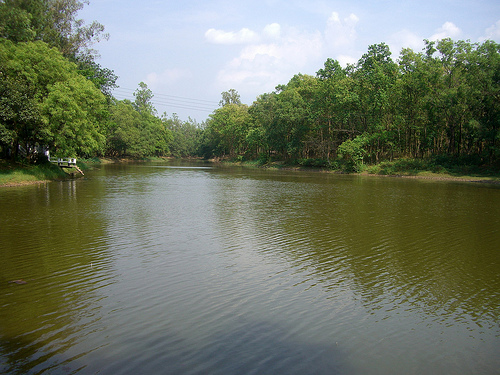

Location: Gazipur, Dhaka Division Map
Area: 5022 hectares
Entrance Fee: 6 Taka
Car: 30 Taka, Minivan 50 Taka
Bhawal National Park is situated 40km north of Dhaka city near
Gazipur in the Dhaka Division of Bangladesh. Bhawal National Park
covers an area of 5022 hectares. Currently the park undergoes major
changes on its grounds. The park over past decades became overrun by
local displaced people who extracted firewood, hunted animals to
extinction and found shelter on its ground. All these seem to change
in the next few years. The administration of the park introduced
quiet or silent zones within the park to keep local people from
playing music, celebrating events and thus scarring animals away
from this region. Additionally several species were reintroduced to
the park including fishing cats, spotted deer, peacocks, several
species of pythons and etc. Overall the park contains over 13
species of mammals, 9 reptiles, 5 amphibians, 5 avis and over 220
plant species.
The easiest way to get to the Bhawal National Park is to rent a car
or a bus if you in the group. If you are on more adventurous and
quiet frankly kind of stupid side, you can a local bus from a
Mohakhali bus station in the town of Dhaka heading for Mymensingh.
After spending about an hour in a packed bus with humans and
possibly animals, you will see an entrance to the park. Going back
is just as tricky.
Bhawal National Park was established and maintained as a National
Park in 1974; it was officially declared in 1982 under the Wildlife Act
1974. Originally it was the forest of Madhupur under the management of
Bhawal Estate. The park is located in Gazipur, Dhaka subdivision of
Bangladesh, about 40 km north of Dhaka city, only 20 km from Gazipur and
20 km from Kapasia. The core area of the park covers an area of 940
hectares but extends to 5,022 hectares of surrounding forest. Its
purpose is to protect important habitat areas as well as provide
breeding opportunities for species. The park has been listed in IUCN
Management Class V as a protected area. The most common flora is the
unique salpice forest. The area is also known for its fauna including
peacocks, tigers, leopards, black panthers, elephants, clouded leopards
and sambar deer. However, much of the wildlife has disappeared and now
only a few species remain. In addition, most of the forests have been
wiped out and are currently occupied by forestry companies or by
migrants.
Fifty years ago, most of this area was covered with
forests and the dominant species was Sal (Shorea Robusta). Illegal
deforestation has reduced the remaining forest area to about 600 km²,
and now new trees and forests have been replanted.
The park has 345 species of plants, including 152 different species of trees, 53 shrubs, 106 herbs, and 34 species of climbing plants. Wildlife in the park includes 13 mammals, 9 reptiles, 5 birds and 5 amphibians. In addition, the Forest Department recently introduced peacocks, deer, pythons and catfish.